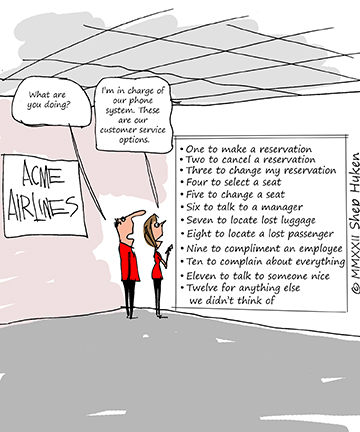
I listened to the prompts. I was at number four, thinking this one might be it, but I wasn’t 100% sure, so I kept listening. I got to number six when the recording said that I could listen to the options again. I did, and even then, I wasn’t sure which option to choose. I tried pushing “0,” and nothing happened, so I chose number four, thinking that it was the closest to what I needed.
That turned into a seven-minute wait. In all fairness to the company, there was a recording that informed me of how long the wait would be. I multi-tasked while waiting for the customer service rep to join the conversation. Once the rep came on the line, I conveyed my issue. She politely informed me that I had pressed the wrong option. I should have pressed number three, and she would be happy to transfer me.
How nice! That was until I experienced the next recording telling me my hold time would be 18 minutes. I had no choice but to wait. Even though the customer service rep who eventually took my call was friendly, it really didn’t matter. My experience was tainted by the phone tree debacle and the long waits.
I don’t mind a phone tree with several choices, but how many is too many? One of our team members previously worked in support centers, and she said it’s not uncommon to have eight. Eight choices?!
So, now I’m thinking a lot about phone trees. Again, there’s nothing wrong with this type of technology, as long as it’s done the right way.
- Keep the options to just a few. Too many become confusing. A confused customer can become a frustrated customer.
- If you must offer more than three options, consider staying with three and then offering additional options when the customer advances to the next branch on the tree. This could be less confusing.
- Give customers the option of pressing “0” to speak to an operator.
- Once the customer makes a choice, don’t let them down with a long hold time. If you must make them hold, inform them how long it will be. And as long as you have invested in this technology, include the option of a call back when it’s the customer’s turn, rather than forcing them to wait.
- While the customer is holding, the recording should offer suggestions for a self-service option. Our customer service research found that 71% of customers are willing to try self-service. Take advantage of that.
- The customer service rep should know how long the customer has waited since making initial contact. During the welcome, there should be an acknowledgment and apology for the long wait.
Customers wouldn’t be calling support unless they had a problem or question. The company’s goal is not to upset customers when they reach out for help. Make it easy for them to get their answers. Give them the experience they deserve – one that is easy, frictionless, and helpful.



